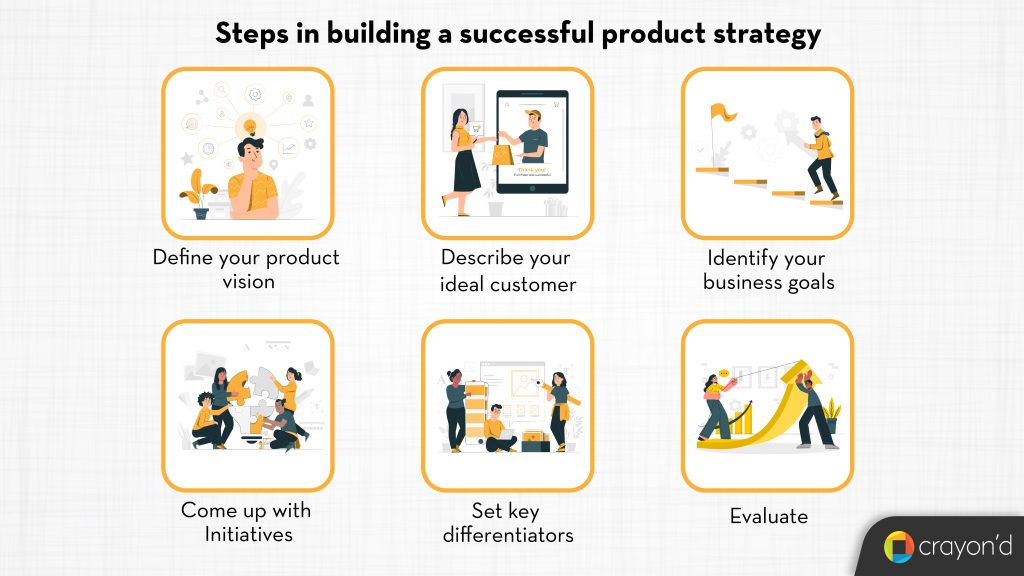Have you ever dreamt of creating a product that revolutionizes the market?
Then, Product strategy is your secret weapon to turn that dream into reality.
It’s a meticulously planned roadmap that guides your product from start to thriving success. Also, it ensures that you deliver exceptional value to both your customers and your product.
Let’s dig into the blog to find out more about the success weapon: A Winning Product Strategy.
What is product strategy?
Product strategy is a high-level plan to fulfill your product goal or vision. It applies to both new and existing products.
It starts with your product vision and guides you through all the stages of your product lifecycle.
This strategic process involves executing the product vision, understanding your customer needs, analyzing market dynamics, and aligning your product roadmap with the overarching goals of your product.
Why is product strategy important?
Is it possible to develop a product without a strategy? If so, then how the end product will be?
Developing a product without a strategy is like navigating in a forest without a map.
Sure, you might stumble upon something interesting eventually, but the journey will be filled with detours, wasted time, and a high chance of getting lost.
That’s what developing a product without a strategy feels like.
While it is technically possible. But leads to poor product market fit, ineffective resource allocation, weak or unclear value proposition, and difficulty to adapt with evolving customers and market needs.
Benefits are undeniable, aren’t they?
But, wondering where do you begin? Don’t worry we have got you covered.
Now, let’s explore how to create a winning product strategy to leverage all the benefits discussed above.
How to create a winning product strategy?
Now that we have seen the elements, it’s important to know how to develop each of them and consolidate them together to come up with an effective product strategy.

- 1. Define your product vision
The strategy, roadmap, and backlog all trace back to the product vision that acts as a foundation. Down the line, everything is based on the vision and so you must define it with consideration.
Let’s see the example of a vision statement from Google
“To provide access to the world’s information in one click”.
To define the vision statements there are a few templates.
For (target customer) who (statement of need or opportunity), the (product name) is a (product category) that (key benefit, a reason to buy).
Unlike (primary competitive alternative), our product (statement of primary differentiation).
To [verb: empower, unlock, enable, create, etc.] [persona] to [benefit, goal, future state].
But there isn’t a predefined way to write your vision statements. You can adhere to the way you like.
This product vision statement should have underlying motivations (here, driving the team towards bringing as much information as possible online), achievable, and concise. It must be linked to the business goals.
- 2. Describe your ideal customer
You need to have proper knowledge of the market you are targeting and the customers your product will be serving. A product might address 2-5 user personas whose needs and expectations differ.
To describe your ideal customer you need to be aware of the following:
- What are Customer characteristics?
- Demographics (age, location, etc.)
- Psychographics (Lifestyle & activities)
- Behavioral nature (purchase decisions)
- What are customer problems and challenges?
- What are customer expectations?
- What according to them is value?
When you fill out the answers, you will have a clear picture of your ideal customer and what you will need to do to satisfy them.
- 3. Identify your business goals
Having clear business goals in place can only help you measure success through defined metrics. An example of a goal can be “Increase the number of customers by 50% in 3 months” or “Improve brand awareness in a particular region by the end of a quarter”. These goals affect various functions related to product development.
How to identify or define your business goals? Here are the steps to do it.
- Conduct a SWOT (Strengths; Weaknesses; Opportunities; Threats) analysis. This helps you analyze the present condition and identify the areas to improve.
- Come up with goals based on the SWOT analysis.
- Review them with your team and select the best ones.
- Make goals SMART (Specific; Measurable; Attainable; Relevant; Time-bound)
- Define KPIs to measure their success.
- 4. Come up with Initiatives
Product initiatives are the large objectives in conjunction with the product goals. They need to be implemented to achieve the business goals.
Initiatives are broken down into smaller actionable items which are used in Roadmaps. These initiatives are anything related to features, products, and platforms.
Let us consider your product goal is to improve the quality of the learning environment, an initiative associated with it can be, “Provide faculty with best training and technology”.
- 5. Set key differentiators
The market is filled with competition. For any product, there are 4-5 alternatives. “What makes your product stand out?” To know this you must define the differentiation factors. These factors govern your value proposition and unique selling point.
Product differentiation shows the potential customers what you can offer them that your competitors can’t. One important thing about differentiation is that it is effective when spoken in terms of benefits to users. Here are the general types of differentiations
- Horizontal
The product offerings are the same and the choice is based on personal preference. For ex: Coca-Cola vs Pepsi
- Vertical
Differentiation happens by considering one factor. For example, if two products have the same quality, the choice is made based on the price.
- Mixed
In this type, differentiation occurs considering a number of factors combined.
You can set your differentiators based on one of these factors that mainly contribute to differentiation.
- Benefits
- Design
- Price
- Product Quality
- Customer Service
- Channels of Distribution
- Marketing Efforts
- Reputation
- 6. Evaluate
Now that you have a defined product vision, goals, and a clear understanding of the target users in place, you have to work on framing the strategy. This must be done in collaboration with the teams. When your product strategy is ready, you can use it to create the roadmap.
But this implementation cannot happen instantly. You will have to evaluate it to find if it’s clear enough. Also, you need to keep reviewing your strategy from time to time.
Top 4 Product Strategy Tools
To ease the creation and validation of strategy, there are several product strategy templates/tools. Let’s have a glimpse of a few of them here.
Vision Board
Created by Roman Pichler (the founder of Pichler consultancy), the product vision board helps you to put the elements of a product strategy together. The board comprises the following sections
- Vision
- Target group
- Needs
- Product
- Business goals

After filling out the sections, you will be able to compare every component and then draw out your product strategy. You can use this board not just for yourself, but also for communicating your idea to others. In addition to that, you can also use the product vision board for testing your strategies as well. For this too, Roman provides a methodology as seen below.

Product strategy canvas
Designed by Melissa Perri (the CEO of Produx Labs), the product strategy canvas is used for building a product strategy by putting together the following elements, instead of the usual ones
- Vision
- Challenge
- Current condition
- Target condition

This helps you focus on one challenge and the desired solution at a time. So you might need several of these canvases to address the number of issues and framing your product strategy. Product strategy canvas also acts as an effective communication tool.
Strategy Kernel Canvas
This tool was created by Chris Butler, helps in putting down the inputs needed for creating a strategy, and enables you to have a good discussion with it.
This one is a little different from the remaining two. This covers the past, present, and future concerning the strategy. The actual strategy will come in the present area. It’s divided into the following parts
- History- What did the company/product try before? What led them here?
- Diagnosis- The problem analysis
- Guiding policy- The approach to overcoming the problem
- Bets- Proposals that connect the policy and actions
- Action/Process- Steps needed to achieve the policies
- Success/Survival- Metrics and KPIs to measure your success. Defining what is a success.

Strategy Map
A strategy map is a great tool for communicating the product strategy across teams. A strategy map consists of four perspectives related to the strategy
- Financial
- Customer
- Internal Business processes
- Learning and Growth
They are placed on four rows which are for writing the objectives of each. These objectives are then linked together as shown below.

Tips for Effective Product Strategy
1. Include product evolution
A product strategy isn’t something that is kept untouched. A product goes through various stages at different points in time. Sticking to the same initial strategy is not a way to win. What worked during the introductory period will not work for the growth period. Everything from business goals and initiatives to customer behavior changes as you advance in the product life cycle.
Constantly altering your product strategy only will help you secure a good place in the ever-changing market.
2. Don’t have a fixed mindset
As you work on product strategy, try to generate as many plans as possible. Don’t incline towards the first idea that came up. All ideas and strategies have two possibilities— to succeed or to fail. Assessing them by asking questions like “Will this help us realize our business goals?”, “Will this approach help in creating a satisfying solution for the end-users?” can help you perfect your product strategy.
Don’t be afraid to fail with ideas. If an idea fails, you will come up with more feasible ones going forward.
3. Focus on problems
An approach that prioritizes customer problems can help you arrive at an effective strategy. When you have the problem as your focus rather than the solution, you will keep looking for better ways to solve it.
Moreover, only when you have clarity on the problem, you can come up with apt solutions.
4. Collaboration is the key
Product strategy should be relevant to every team in the organization. To achieve this, you need to loop in different teams as you create the strategy. Only with a variety of people, do different perspectives come into play.
The collaboration will help you with a 360° analysis of problems concerning the internal teams as well as the customers. This enables you to have better problem visibility.
End note
Just follow these steps and the product strategy tools while continuously iterating based on market feedback, and you’ll be well-equipped to craft a winning product strategy.
Remember, your product strategy is a living document, not set in stone.
Embrace flexibility and data-driven adjustments. This ensures your product stays relevant and thrives in the ever-changing marketplace.
So, are you ready to turn your product vision into a reality that resonates with your target audience and drives success?
Take the first step today and embark on the journey to product triumph!
Ready to stay ahead of the curve?
We delve deeper into product insights with regular tips, updates, and industry trends. Follow us for more to ensure your product remains competitive and thrives in the ever-evolving market!






Add comment